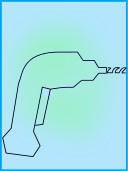Hospitals eTool
Facilities Management » Work-related Musculoskeletal Disorders
Hazards
Employees in maintenance areas are exposed to ergonomic hazards such as repetitive movements, forceful exertions, awkward postures or contact stress while performing routine maintenance and repair job tasks. Exposure to ergonomics-related risk factors may lead to Musculoskeletal Disorders (MSDs) including strain and sprains, back pain, carpel tunnel syndrome, tendonitis, or tenosynovitis.
- Repeatedly lifting the arms or reaching, or supporting a load with the arm elevated or extended, may lead to injuries such as muscle strain or rotator cuff tears.
- Pushing and pulling carts with heavy parts, equipment, and power tools may increase the risk of injury to the back, shoulders, and lower and upper extremities.
- Poorly designed or improperly-used hand tools may require the use of excessive force and cause awkward postures, resulting in tendonitis in hands, wrists and elbows.
- Short handles may press or rub against the palm and fingers causing contact stress. Small handles may also increase force requirements for tools, leading to fatigue, discomfort and pain.
- Tools with wide handle-spans require extended thumb and finger positions to activate the tool. These postures require increased finger force to provide adequate activation force, increasing fatigue, discomfort and pain.
- Improper orientation of the tool handle may result in awkward position of the hand, wrist, or arm and increase force requirements of the task, leading to fatigue, discomfort, and pain.
Recognized Controls and Work Practices
Assess worksites for ergonomic hazards and address ways to decrease them:
- Redesign or reposition tasks to allow elbows to remain close to the body and maintain a neutral (handshake) wrist position.
- Avoid awkward postures, such as bending, twisting, shoulder abduction, and wrist deviation (e.g., reposition work in front of worker rather than reaching above the shoulders or behind the torso).
- Keep objects at waist level if possible, rather than bending over them. Store heavy items (e.g., motors, pumps) between knees and shoulders, or use a pallet jack if stored on the floor.
- Use step-stools or ladders to avoid or limit overhead reaching.
- Use knee pads when kneeling.
- Select properly designed tools that fit the user. For example, use tools with extended handles.
- Reduce repeated motions, forceful hand exertions, and prolonged bending. Avoid tight and static grip and alternate leading hand.
- Use a properly designed tool to promote neutral posture of the wrist and hand. Generally, an inline tool is best on horizontal surfaces at about waist height, and a pistol grip is preferable for vertical surfaces at about waist height. Bent-handled tools can be designed to accommodate differing work positions and angles.
- Use tools with padded grips and non-slip handles that extend across the whole palm of the hand to minimize contact pressure.
- Ensure that tools such as screwdrivers have appropriately sized and shaped handles. Generally, handles that are about 1 1/2 inches to 3 inches in diameter, and that are triangular with rounded edges, provide a better grip.
- Use power tools to do the job when repetitive or prolonged force exertion is required. Select power tools that have minimal vibration, or use vibration dampening devices and vibration-dampening gloves.
- Use trigger bars rather than single finger triggers.
-
Use rolling carts, with large, low-resistance wheels, that can easily roll over mixed flooring as well as gaps between elevators and hallways. Keep carts well-maintained to minimize the amount of force exerted while using these items.

Trigger bar. 
Lighten Load. - Use handles to move carts rather than the side of the cart to prevent the accidental smashing of hands and fingers. Push rather than pull whenever possible.
- Lighten a load that needs to be lifted or get help when lifting heavy or bulky loads. Train workers to use proper lifting techniques for lifting and carrying loads.
- Use mobile tool box or bucket-style tool bag instead of a tool belt.
- Use padded belts and suspenders to evenly distribute the weight between the shoulders and the waist, thus reducing contact stress. Arrange tools in bags so that their weight is distributed evenly.
- When possible, reduce the weight of the tool belt by reducing the number of tools carried to those necessary for the task.
Additional Information
- Electrical Contractors. OSHA eTool.
- Ergonomics. OSHA Safety and Health Topics Page.
- A Guide to Selecting Non-Powered Hand Tools. U.S. Department of Health and Human Services (DHHS), National Institute for Occupational Safety and Health (NIOSH) and California Occupational Safety and Health Administration (Cal/OSHA), (August 2004).
- Inspection Guidance for Inpatient Healthcare Settings. (June 25, 2015). OSHA memorandum establishing guidance for inspections conducted in inpatient healthcare settings.
- Also see Hospital-wide Hazards - Work-related Musculoskeletal Disorders.

